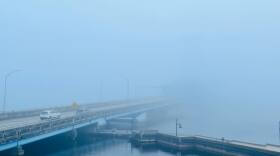On November 21, the Fort Myers Historic Preservation Commission denied The Laboratory Theater of Florida’s retroactive application for permission to place a mural on the Second Street side of its building at 1634 Woodford Ave. The Fort Myers Mural Society had installed the mural in June. It depicts the opposing masks that symbolize the two main genres of theater, comedy and tragedy.

“We were approached by the muralists to do that mural,” Lab Theater co-founder and Vice President Nykkie Rizley told the Commission on November 21. “The muralists were funded by a grant by the City of Fort Myers.”
In its quest to make Fort Myers synonymous with high-quality murals, the Fort Myers Mural Society is always looking for new mural locations. What happened next isn’t entirely clear.
Executive Director Shari Shifrin says the mural society researched whether the theater building had a historical designation, but did not find it included in the city’s inventory of historical structures.

Rizley acknowledged that Lab Theater had applied for historic designation in 2018, but was not aware that as a result it could not put anything on the building that alters or covers up historic features such as window openings.
The building was originally constructed in 1923 by St. Luke’s Episcopal Church. It is an example of Mediterranean Revival architecture, with some Mission influence. It is the oldest church building in the Fort Myers area.

Lab has chosen not to pursue its right to appeal HPC’s decision to the City Council.
“We respect their decision and appreciate the offer from the board to help our not-for-profit theater with this endeavor,” said Rizley following the November 21 HPC meeting.
Part of the mural was affixed to the building by means of lightweight aluminum panels. They’ve already been taken down.
The part of the mural that’s been painted directly on the stucco is yet to be painted over. To make sure that it is, Code Enforcement presumably opened a new case on December 3.
But even after the mural has been painted over, that may not be the end of the matter. There remain other alterations that potentially interfere with the building’s historic character. Watch this space for further developments.

MORE INFORMATION AND SOME HISTORY:
The Fort Myers Mural Society is a nonprofit, 501(c)(3) organization whose stated objectives include the revitalization, preservation and economic enhancement of the community through the painting of murals that depict the rich history of our area. Since its inception, the society has sought to establish Fort Myers as a mural destination on par with such recognized mural cities as St. Petersburg, Hollywood, Palatka and Punta Gorda.
After receiving a grant from the City of Fort Myers, the society approached Lab Theater about incorporating a mural on the south wall of the theater. The Lab readily agreed.
Sometime after the mural was installed, a city employee took notice and asked internally whether Historic Preservation approval had been sought and received. Finding that it had not, Code Enforcement issued a Notice of Violation (COD-034803-2024) on June 27, 2024.
Neither Code Enforcement, city staff nor the Historic Preservation Commission has alleged or suggested that Lab Theater and the Mural Society's failure to seek proper review and permission for the mural was deliberate. To the contrary, the oversight appears unintentional.
Mural Society Executive Director Shari Shifrin maintains that she and the mural society conduct research into all prospective mural sites.
In 1981, the City of Fort Myers initiated a survey of the city’s historic resources. More than 1,500 sites, objects, structures and buildings were entered into the inventory identified by that survey. Approximately 150 of these resources were grouped into six historic districts.
Shifrin said that St. Luke’s Episcopal Church does not appear on that inventory of historic landmarks. She also said that her research failed to discover Ordinance No. 3854 dated January 7, 2019, in which the City Council designated 1634 Woodford Avenue as a local historic landmark.
Finding no apparent impediment to placing the mural on the building, Shifrin and the mural society duly applied to the City’s Public Art Committee for approval of the mural's design. The Public Art Committee approved the design. It had previously identified The Laboratory Theater of Florida as an “art hub,” placing a sculpture by Columbian artist Edgardo Carmona named “Deshove” or “Fertilization” on the grounds in recognition that The Lab is a cultural destination.
As for Lab Theater, Rizley and the theater’s board, officers and employees believed, incorrectly, that as long as they did not make any structural alterations to the building’s exterior, they were authorized to make whatever cosmetic changes they desired in spite of the building’s historic designation.
However, the city’s Land Development Code and Guidelines (Chapter 114 Historic Preservation) together with the Secretary of the Interior’s Standards for Rehabilitation prohibit any changes to the exterior of a historic landmark that alter or conceal “distinctive features, finishes and construction techniques or examples of craftsmanship that characterize a property.”
The mural society and Lab Theater did seek retroactive permission for the mural, but city staff recommended rejection of their Certificate of Review because “the mural, and its mounting material, completely covers two (2) of the five (5) arched windows, altering and obscuring distinctive historic features of the building … [and] [a]ltering the historic arched windows dominating the Second Street façade is detrimental to the historic character of the building.”
City Staff also maintained that “per the Design Guidelines for Historic Properties, windows are often critical parts of the style of a building and alterations should remain in proper proportion to the overall design of the building.” [The Historic Preservation Commission cited a related provision, 114-72(a)(3), to deny John A. Carbona’s Application for Certificate of Review earlier in the November 21 HPC meeting seeking permission to replace the doors and windows on Casa Rio with PGT single-hung windows and PGT Windoors with black finish.]
As mentioned, St. Luke’s Episcopal Church dates back to 1923, but the Episcopal Mission had its origins in Fort Myers in 1885. The congregation, which consisted at that time of eight adults and six children, named itself for Saint Luke the physician in honor of one of its founding members, Dr. William Hanson.
Three years later, Major James Evans donated a lot located at the junction of Second Street and Anderson Avenue (now Dr. Martin Luther King, Jr. Boulevard) and St. Luke’s erected its first church and sanctuary there. The altar was nothing more than a dry goods box draped by a sheet. The pews consisted of rough planks laid across more wooden dry goods boxes. The parishioners carried lamps and lanterns from home to provide lighting during evening services.
By 1920, St. Luke’s had outgrown their small church. The church sold 10 acres that Hanson had given them previously, and it applied the proceeds of sale to purchase the property on Second Street and Woodford Avenue.
St. Luke’s parishioners worshipped there from the date of the church’s completion in 1923 until they relocated in 1969 to their present sanctuary on Cleveland Avenue.
The church building was transferred on June 6, 1969, to the Dr. R.Q. Richards Foundation, which sold the property to Lab Theater on April 28, 2017.
The mural society removed, at its own expense, the two aluminum panels that covered the central windows on the Second Street façade of the building. They will presumably also paint over that part of the mural that was painted on the stucco covering the building’s façade.

At present, there are no plans to paint the mural on Lab Theater’s educational buildings, for which there exists no historic designation. However, that may not matter as any mural installed within a historic district requires approval by the Historic Preservation Commission, which may have concerns about the scale and content of the mural in relation to the character of the surrounding properties.
Removal of the mural may not be the end of this story. In its report to the Historic Preservation Commission, city staff noted that “the windows facing Second Street were painted over and shutters were installed (without permits) after the building was designated a local landmark … The decorative shutters were never approved by the Commission and have a significant impact on the historic character of the building.”

In addition to being a founding member and Vice President of the Laboratory Theater of Florida, Nykkie Rizley has directed a number of shows for Lab Theater, including "Killer Joe," "Hand to God," "Veronica's Room," "Twelfth Night," "The House of Yes," "One Flew Over the Cuckoo's Nest" and "BUG."
In addition to judging 24-hour playwriting projects for The Lab, Rizley teaches theater classes at Lab Theater (including Acting I and II as well as Acting for Seniors). Nykkie has a degree in Theater Prop Design from Grand Valley State University in Michigan (she’s a Laker) and trained in both Chicago and New York.
Support for WGCU’s arts & culture reporting comes from the Estate of Myra Janco Daniels, the Charles M. and Joan R. Taylor Foundation, and Naomi Bloom in loving memory of her husband, Ron Wallace.







